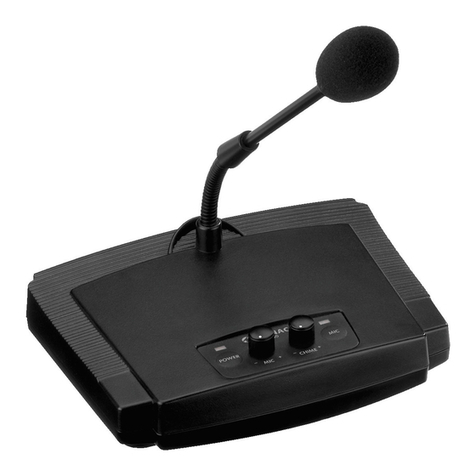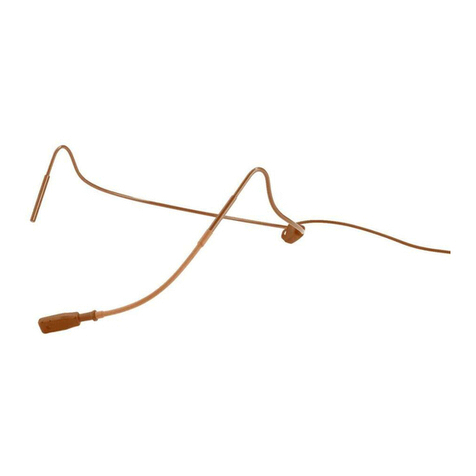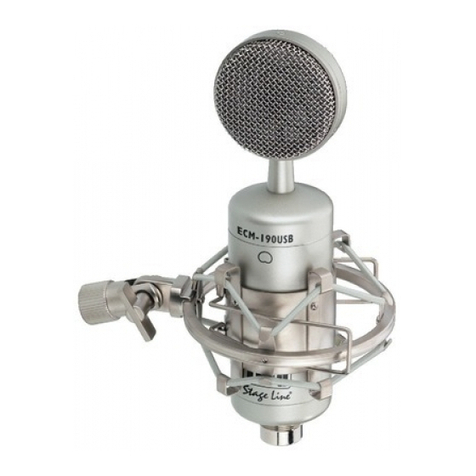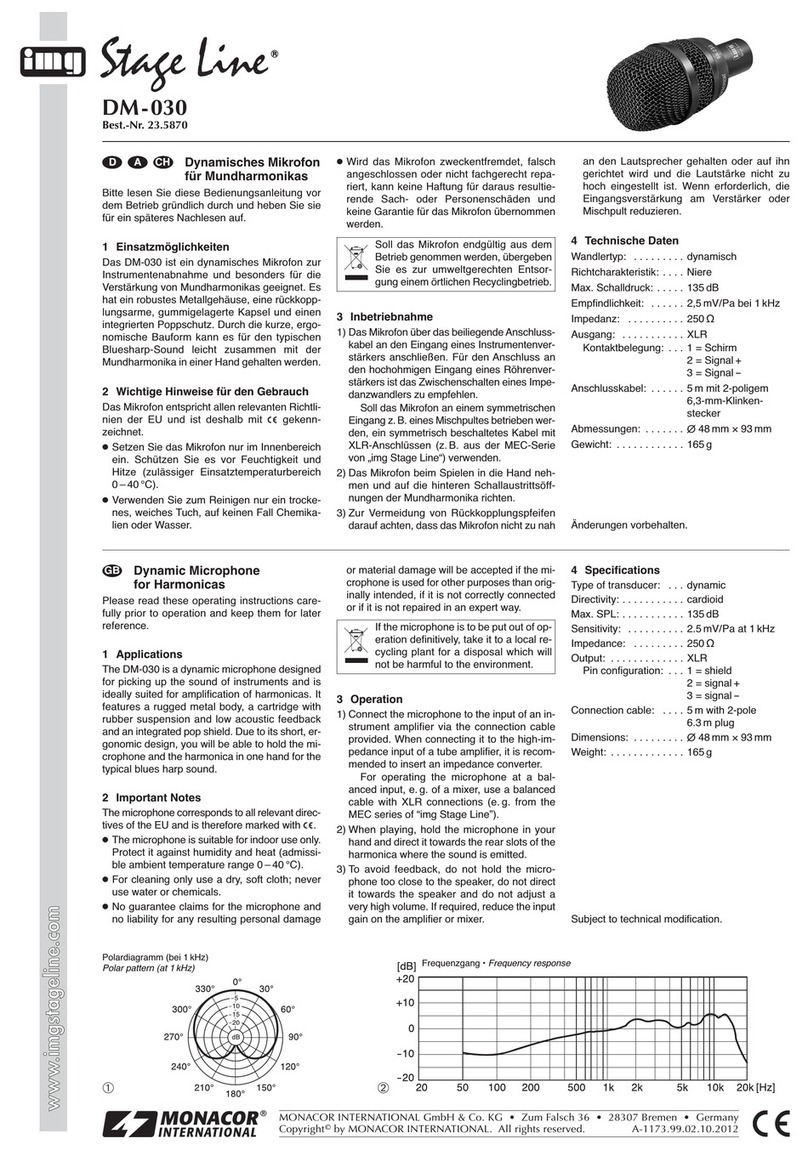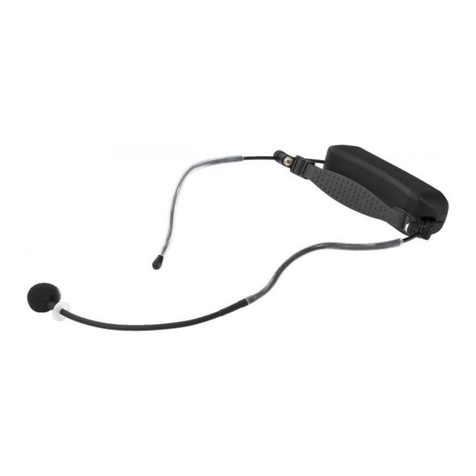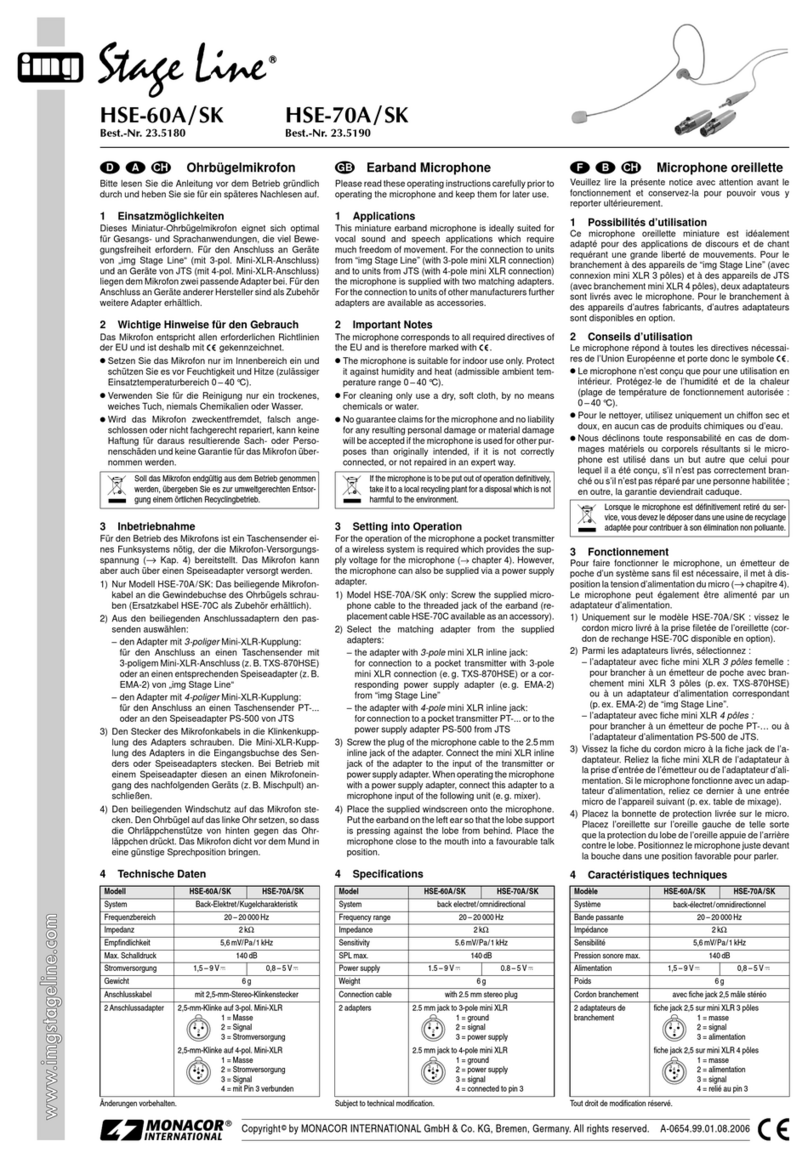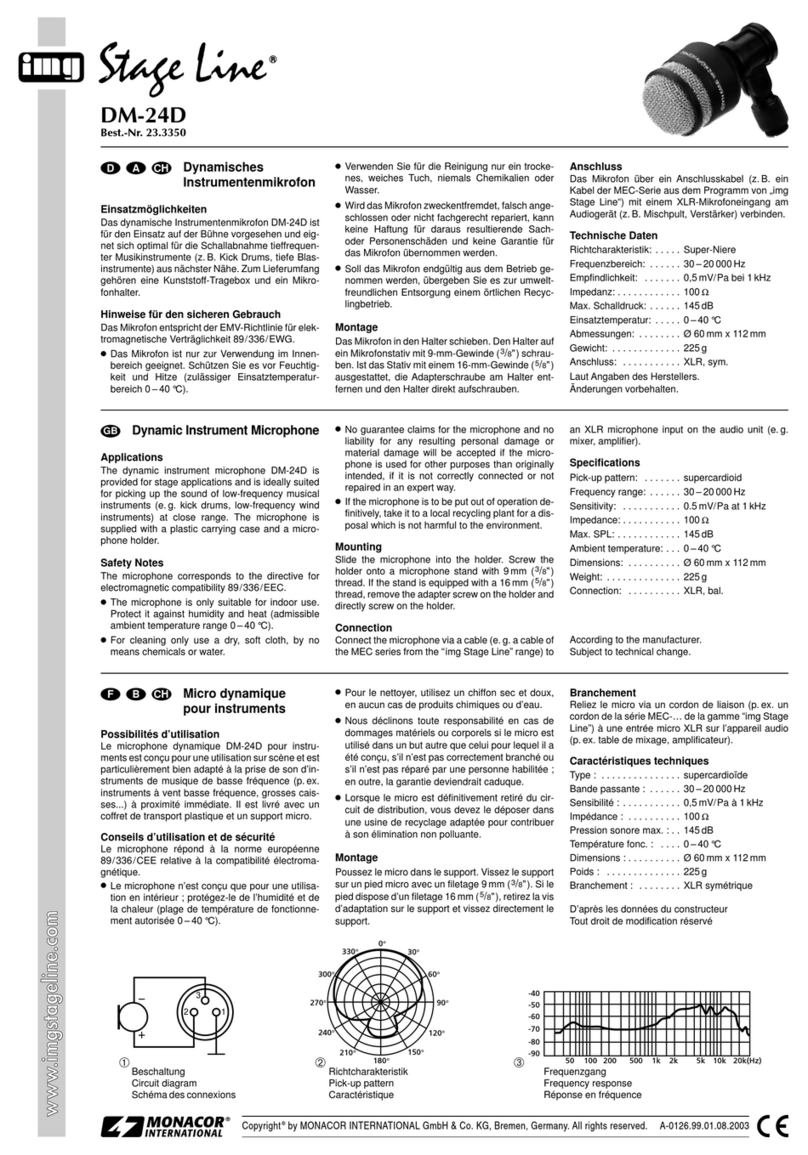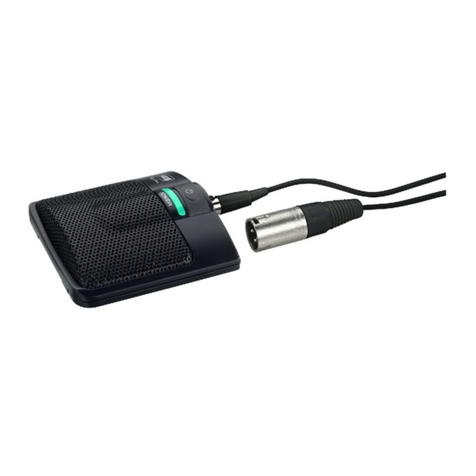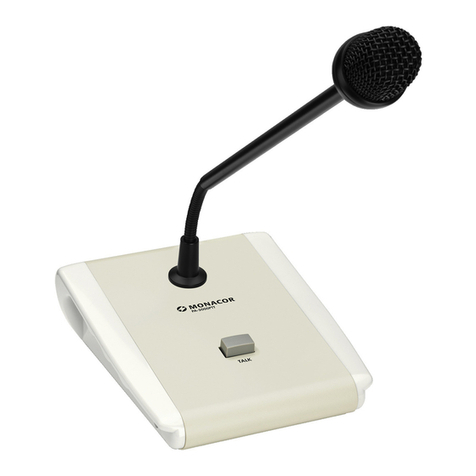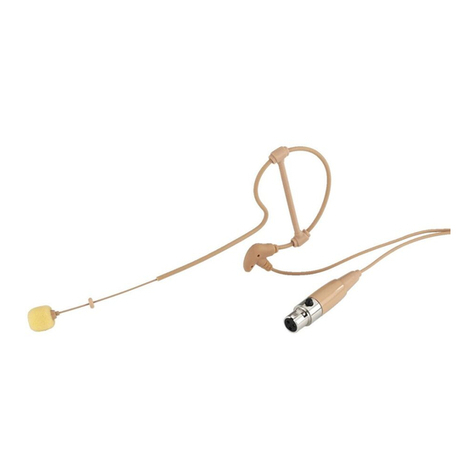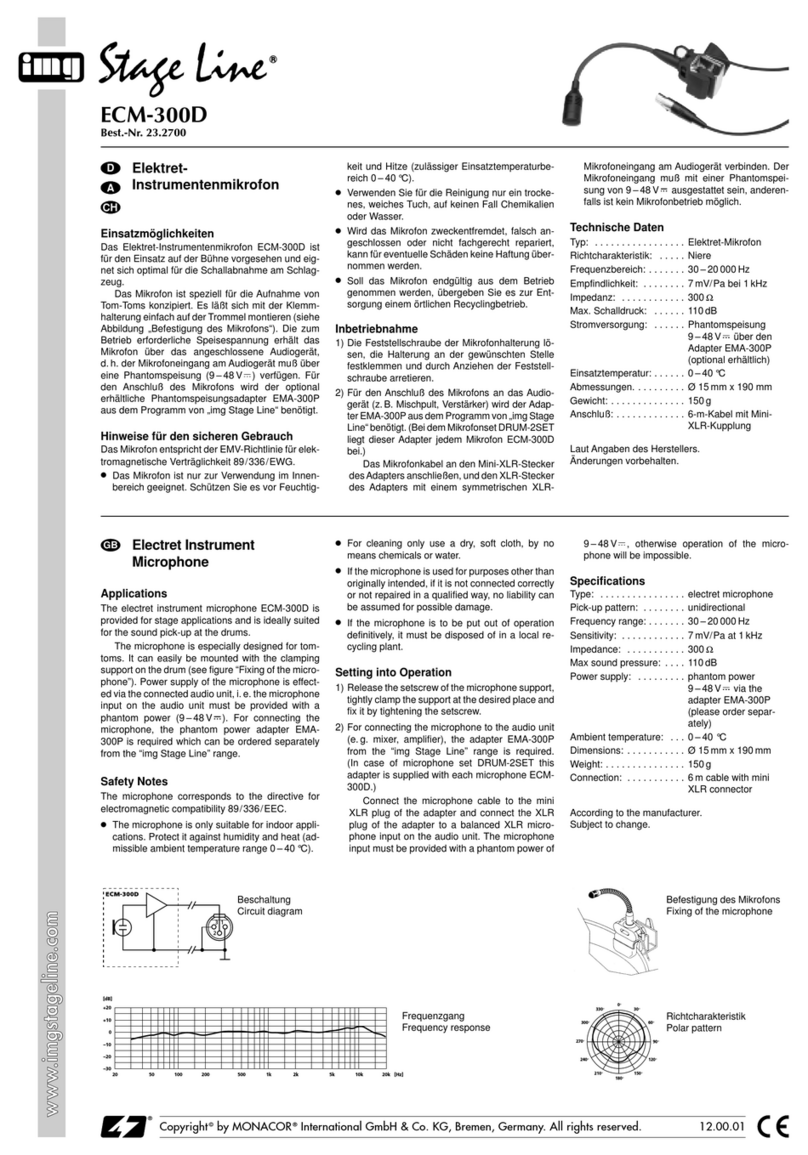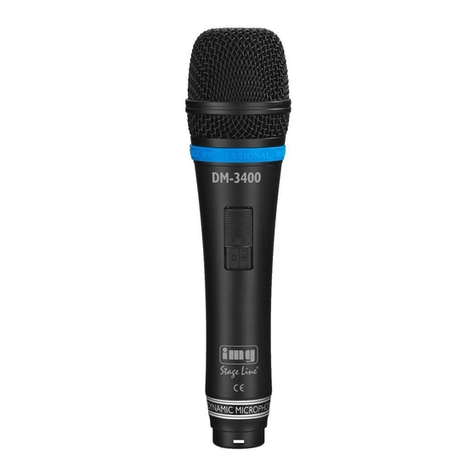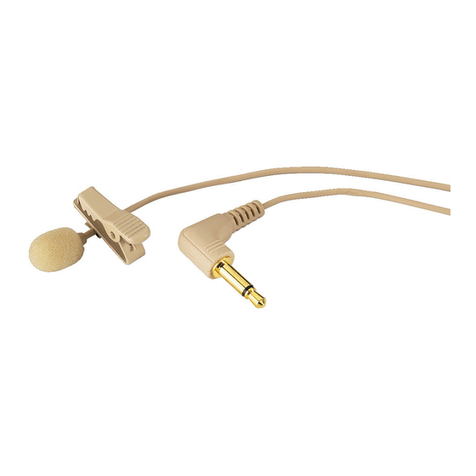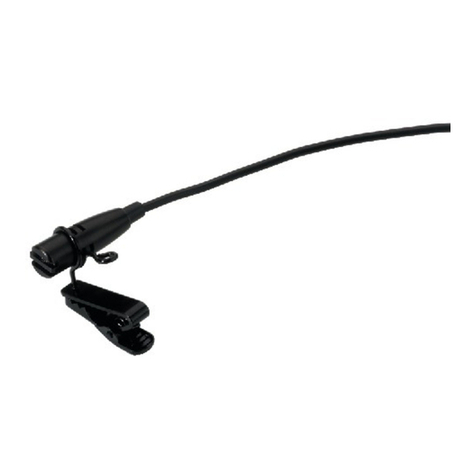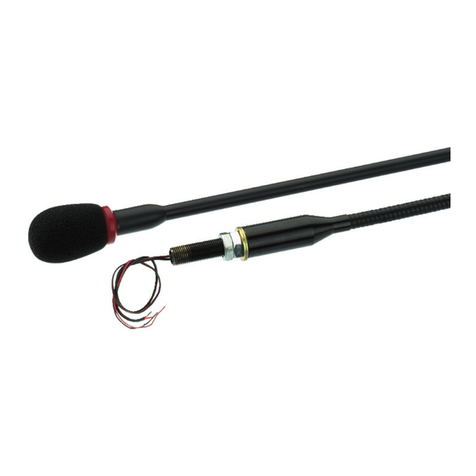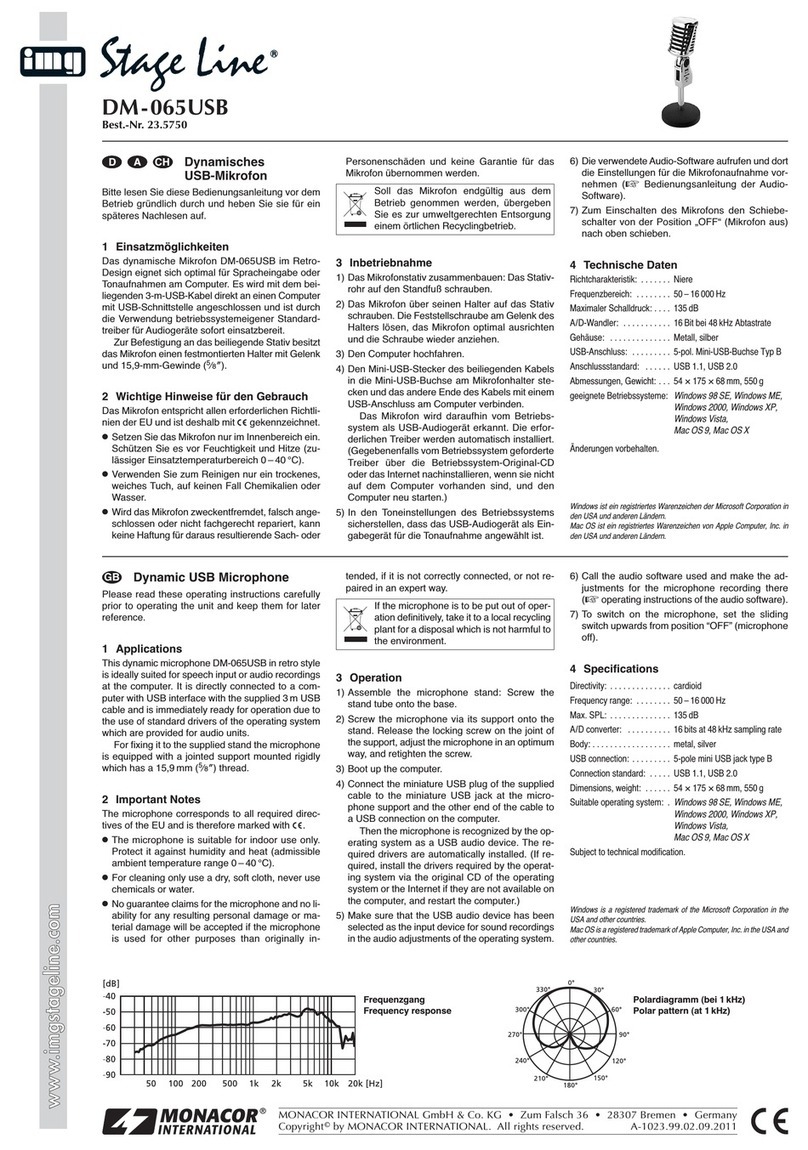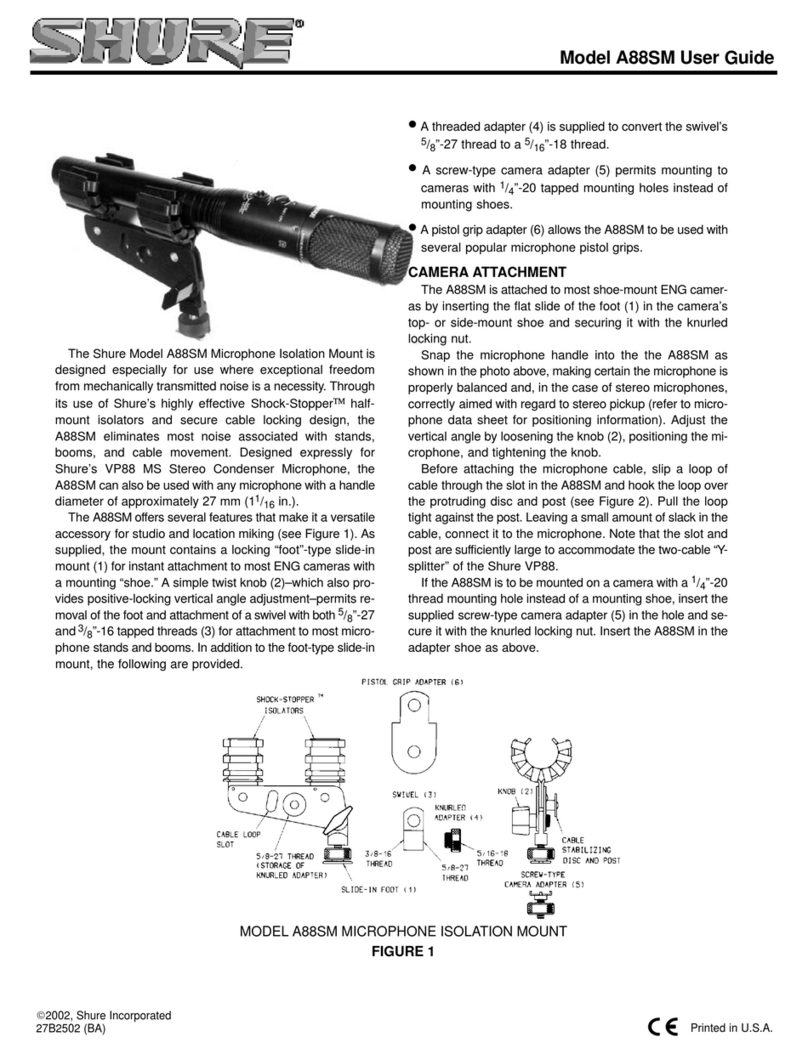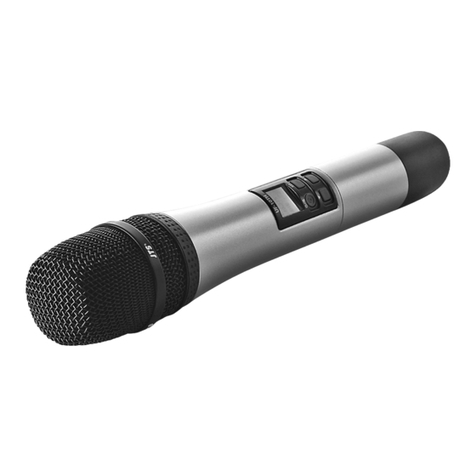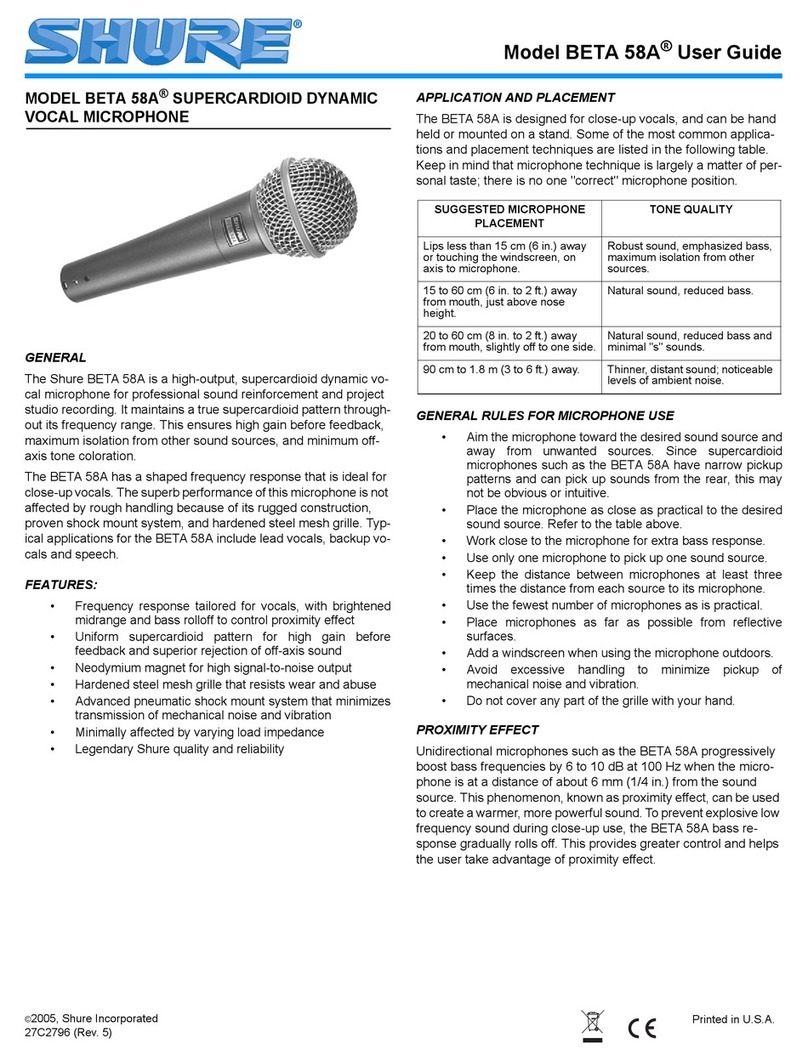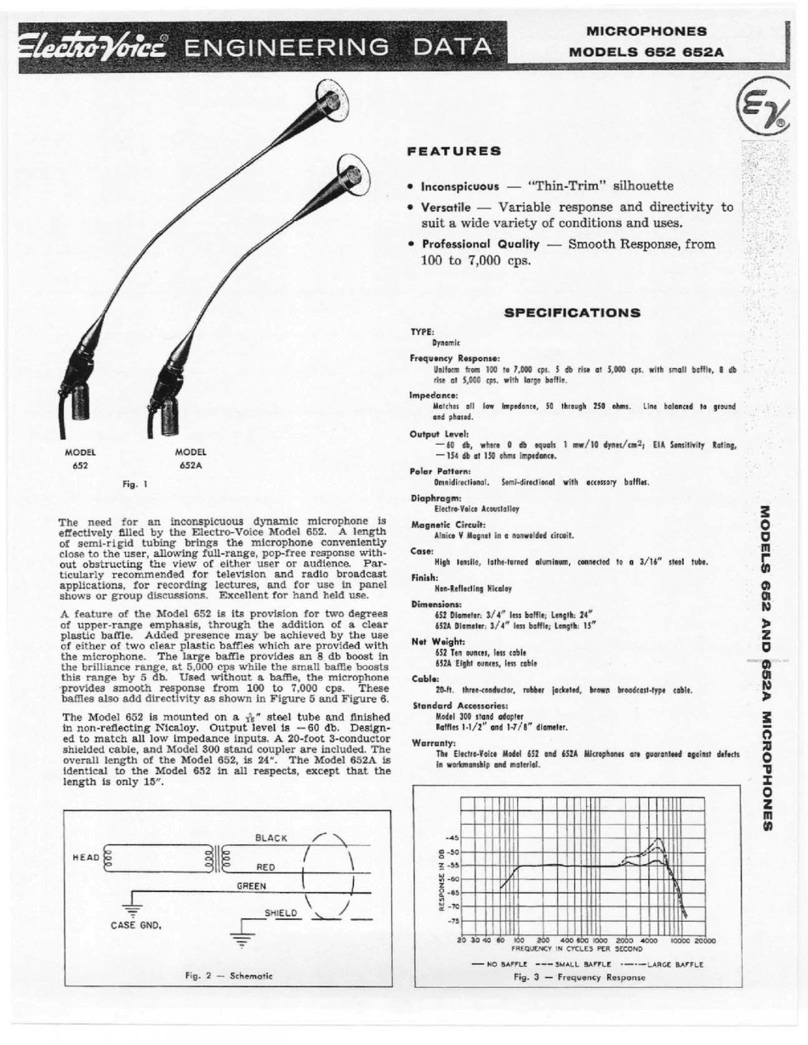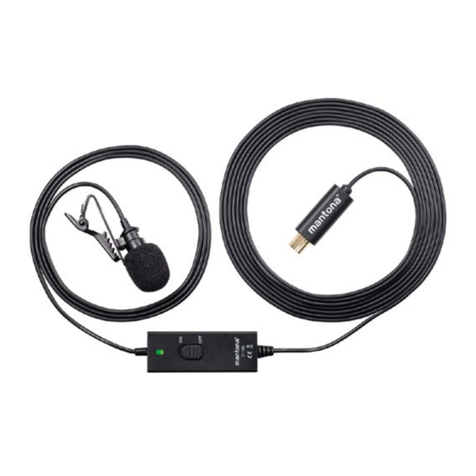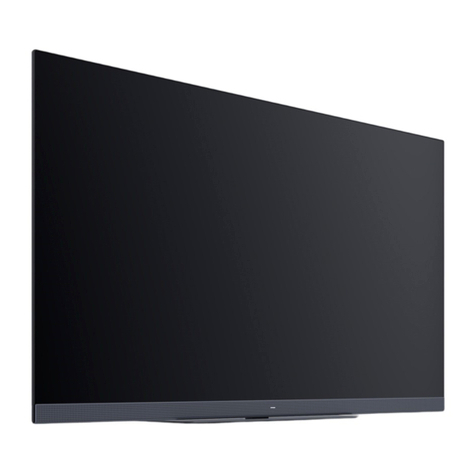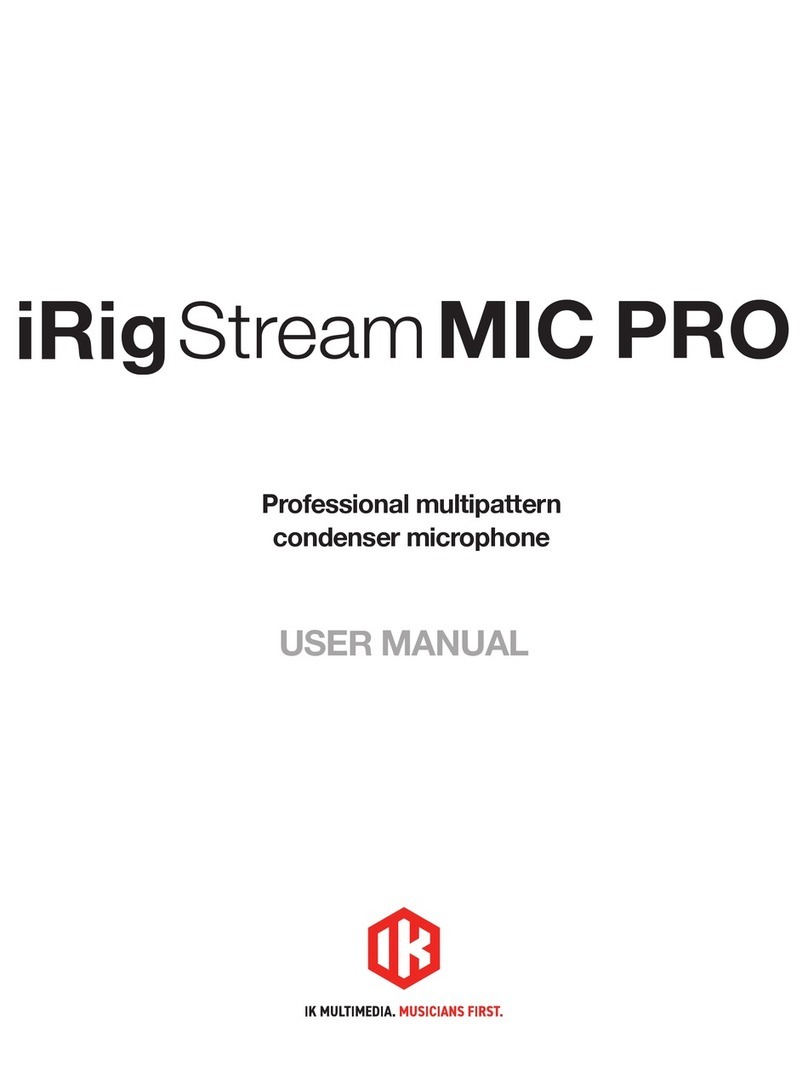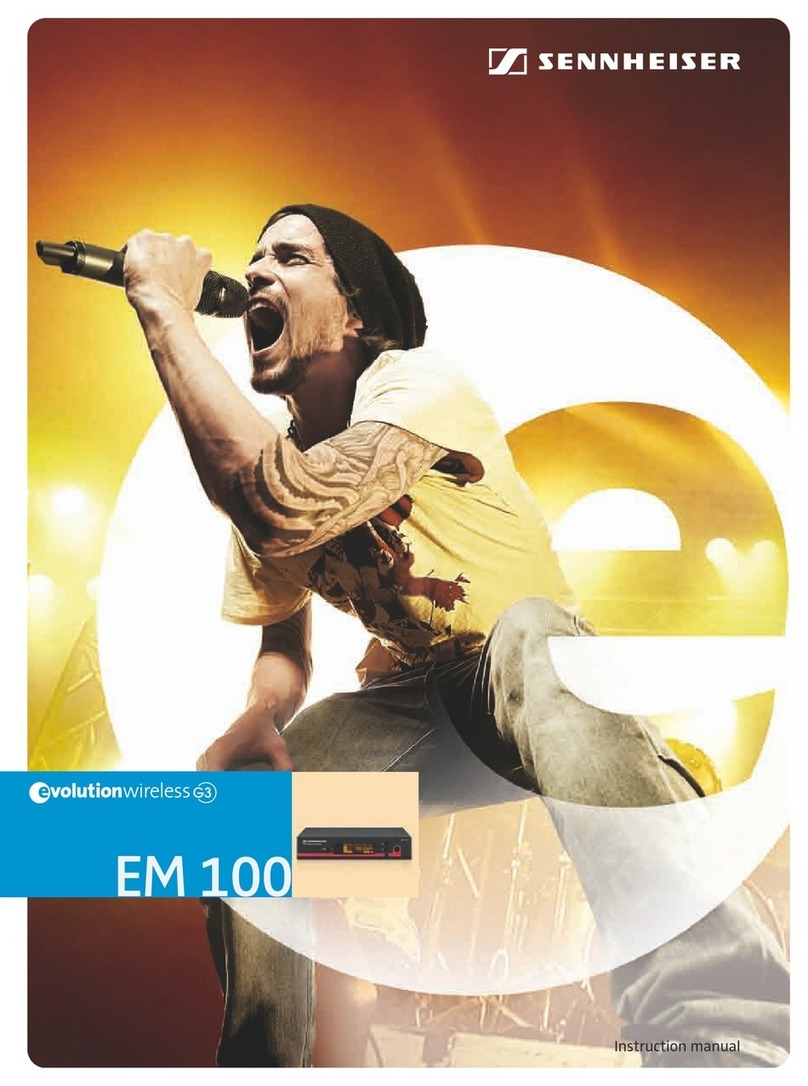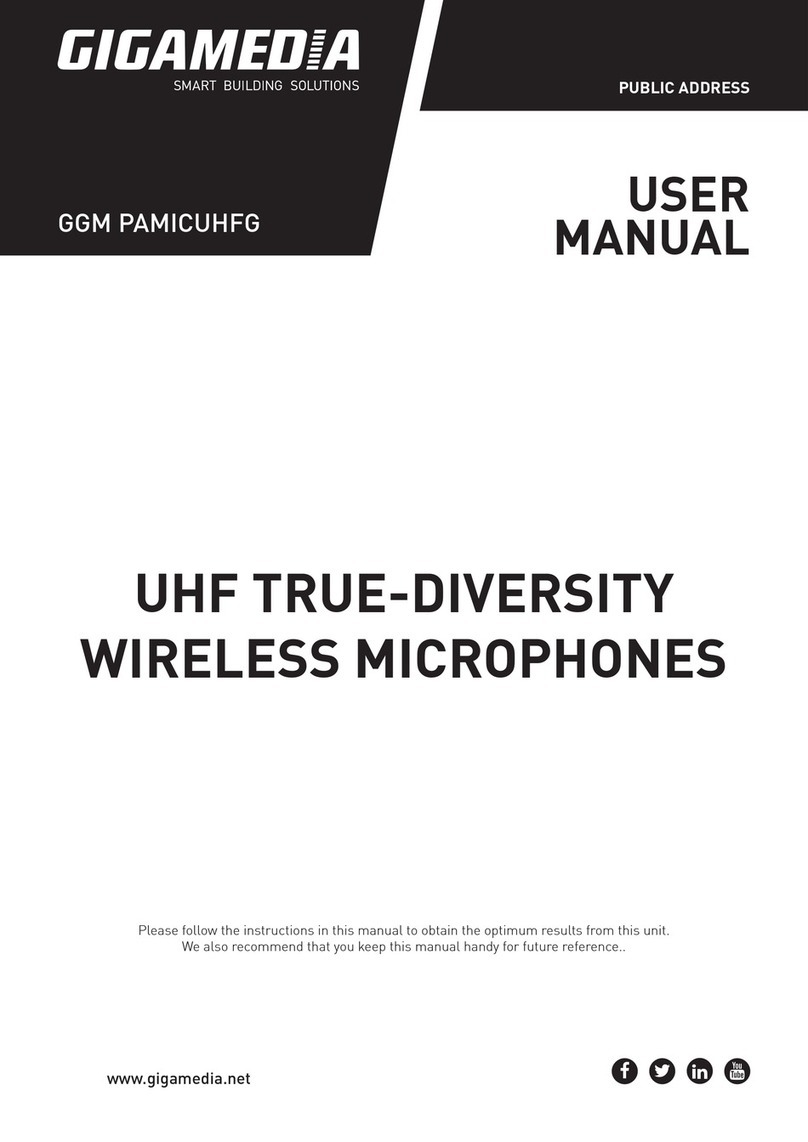Dynamisches Mikrofon
1 Einsatzmöglichkeiten
Dieses hochwertige dynamische Mikrofon mit Nierencharakteristik
ist für die Schallumwandlung von Sprache und Musik auf der
Bühne, im Theater, in der Disco und in ähnlichen Einsatzbereichen
konzipiert. Es wird mit einem Mikrofonhalter, einer Tasche und
einem 6m langen Low-Noise-Kabel geliefert.
2 Hinweise für den sicheren Gebrauch
Das Mikrofon entspricht der EMV-Richtlinie für elektromagnetische
Verträglichkeit 89/336/EWG.
●Das Mikrofon ist nur zur Verwendung im Innenbereich geeignet.
Schützen Sie es vor Feuchtigkeit und Hitze (zulässiger Einsatz-
temperaturbereich 0–40°C).
●Verwenden Sie für die Reinigung nur ein trockenes, weiches
Tuch, auf keinen Fall Chemikalien oder Wasser.
●Wird das Mikrofon zweckentfremdet, falsch angeschlossen oder
nicht fachgerecht repariert, kann für eventuelle Schäden keine
Haftung übernommen werden.
●Soll das Mikrofon endgültig aus dem Betrieb genommen werden,
übergeben Sie es zur Entsorgung einem örtlichen Recycling-
betrieb.
3 Inbetriebnahme
Das Mikrofon und dasAnschlußkabel sind symmetrisch ausgelegt,
der Klinkenstecker jedoch asymmetrisch (siehe untere Abbildung).
Damit ist nur ein asymmetrischerAnschluß möglich. Soll das Mikro-
fon symmetrisch angeschlossen werden, den 2poligen Klinken-
stecker durch einen 3poligen Klinkenstecker oder einen XLR-
Stecker ersetzen.
1) Das Mikrofon über dasAnschlußkabel mit dem Mikrofoneingang
einesAudiogerätes (z.B. Mischpult, Aufnahmegerät, Verstärker)
verbinden.
2) Für den Betrieb das Mikrofon mit dem Schiebeschalter einschal-
ten (obere Position).
3) Wird das Mikrofon nicht benötigt, den Schiebeschalter in die
untere Position stellen. Das Mikrofon ist damit abgeschaltet.
4 Technische Daten
Frequenzbereich: . . . . . . . 50–17000Hz
Empfindlichkeit: . . . . . . . . 1,3mV/Pa bei 1kHz
Richtcharakteristik: . . . . . Niere
Impedanz: . . . . . . . . . . . . 200Ω
maximaler Schalldruck: . . 130dB
Einsatztemperatur: . . . . . 0–40°C
Gehäuse: . . . . . . . . . . . . . Zinkguß
Abmessungen: . . . . . . . . . Ø 51mm x 165mm
Gewicht: . . . . . . . . . . . . . . 280g
Anschluß
Mikrofon: . . . . . . . . . . . XLR, sym.
Kabel: . . . . . . . . . . . . . XLR, sym./6,3-mm-Klinke, asym.
Laut Angaben des Herstellers.
Änderungen vorbehalten.
DM-3700 Best.-Nr. 23.2520
Copyright©by INTER-MERCADOR GmbH & Co. KG, Bremen, Germany All rights reserved. MONACOR®International 09.00.01
wwwwww..iimmggssttaaggeelliinnee..ccoomm
Dynamic Microphone
1 Applications
This high-quality, dynamic, unidirectional microphone is designed
for the sound conversion of speech and music on stage, in the
theatre, in the disco or for similar applications. It is supplied with a
microphone support, a bag, and a 6m low noise cable.
2 Safety Notes
The microphone corresponds to the EC directive for electromagne-
tic compatibility 89/336/EEC.
●The microphone is only suitable for indoor use. Protect it against
humidity and heat (admissible ambient temperature range
0–40°C).
●For cleaning only use a dry, soft cloth, by no means chemicals or
water.
●If the microphone is used for purposes other than originally in-
tended, if it is not connected correctly or not repaired in an expert
way, no liability can be assumed for possible damage.
●If the microphone is to be put out of operation definitively, it must
be disposed of in a local recycling plant.
3 Setting into Operation
The microphone and the connection cable are balanced, however,
the 6.3mm plug is unbalanced (see fig. below). Thus, only an un-
balanced connection is possible. For balanced connection of the
microphone, replace the 2-pole plug by a 3-pole plug or an XLR
plug.
1) Connect the microphone via the cable to the microphone input of
an audio unit (e.g. mixer, recording unit, amplifier).
2) For the operation switch on the microphone with the sliding
switch (upper position).
3) If the microphone is not required, set the sliding switch to the
lower position. Thus, the microphone is switched off.
4 Specifications
Frequency range: . . . . . . 50–17000Hz
Sensitivity: . . . . . . . . . . . . 1.3mV/Pa at 1kHz
Directivity: . . . . . . . . . . . . unidirectional
Impedance: . . . . . . . . . . . 200Ω
Max. sound pressure: . . . 130dB
Ambient temperature: . . . 0–40°C
Housing: . . . . . . . . . . . . . zinc casting
Dimensions: . . . . . . . . . . . Ø 51mm x 165mm
Weight: . . . . . . . . . . . . . . . 280g
Connection
microphone: . . . . . . . . . XLR, bal.
cable: . . . . . . . . . . . . . . XLR, bal./6.3mm plug, unbal.
According to the manufacturer.
Subject to change.
Beschaltung
Circuit diagram
D A CH
GB
